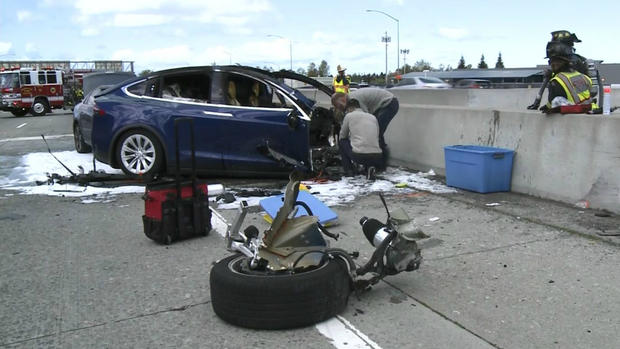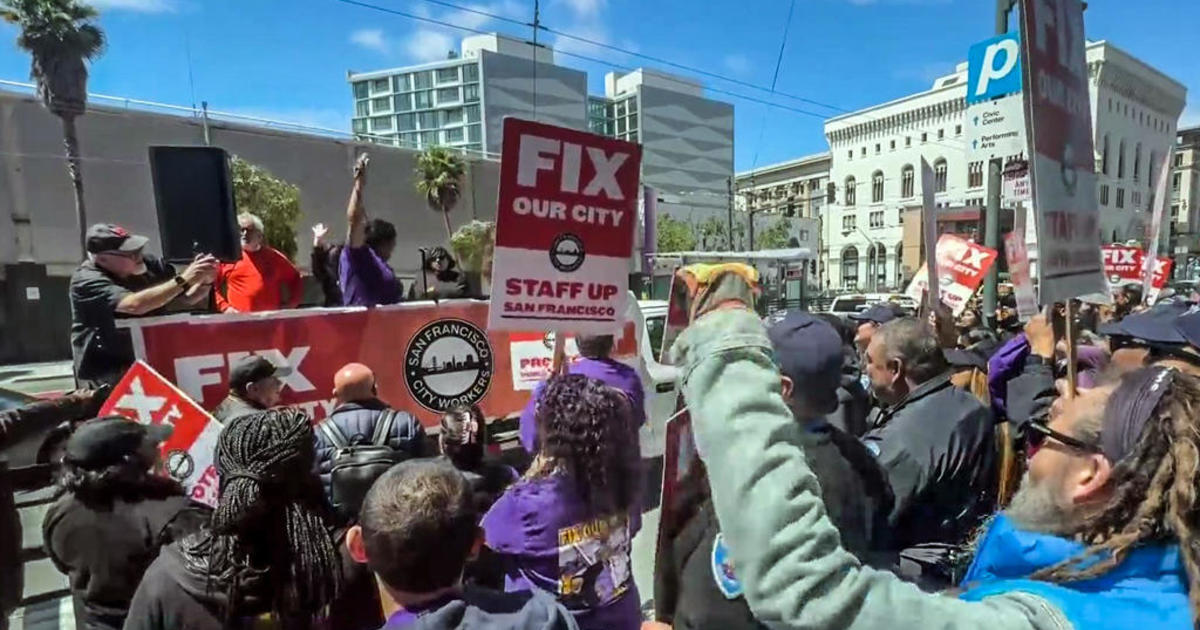Apple Engineer Playing Smartphone Video Game During Fatal Mountain View Tesla Crash
SAN FRANCISCO (CBS SF) -- An Apple engineer, who was killed two years ago in a fiery Tesla crash on a Silicon Valley freeway, was playing a video game on his smartphone at the time of the accident, the National Transportation Safety Board announced at a hearing Tuesday.
The NTSB hearing was being held to release the agency's findings of a nearly two-year investigation surrounding the death of Walter Huang in a fatal March 2018 Highway 101 crash.
Among the focus of the investigation was the use and safety of Tesla's auto pilot function.
NTSB Chairman Robert Sumwalt opened the hearing by saying that partially automated driving systems like Tesla cannot drive themselves. Yet drivers continue to use them without paying attention. He said the board has made recommendations to six automakers to stop the problem and only Tesla has failed to respond.
"What struck me most about the circumstances of this crash was the lack of system safeguards to prevent foreseeable misuses of technology," he said in his opening statement. "Industry keeps implementing technology in such a way that people can get injured or killed, ignoring this Board's recommendations intended to help them prevent such tragedies."
Federal investigators said Huang -- a video game developer for Apple -- had his hands off the steering wheel and was playing a game on his smartphone at the time of the crash. He was not paying attention to the road and the Autopilot function was guiding the car.
"If you own a car with partial automation, you do not own a self-driving car," Sumwalt said. "Don't pretend that you do. This means that when driving in the supposed 'self-driving' mode: you can't sleep; you can't read a book; you can't watch a movie or TV show; you can't text; and, you can't play video games. And, that is precisely what we found in this crash – the driver was playing a video game on his smartphone when his car veered into the median barrier."
The NTSB also slammed the U.S. Department of Transportation for failing to pass regulations on autonomous vehicles. Sumwalt was also critical of Apple, saying the Silicon Valley tech giant should have a policy in place instructing its employees not to use its devices while behind the wheel.
"The crash driver's employer, Apple, is a tech leader, but like most employers, has yet to develop a distracted driving policy," Sumwalt said.
Apple told KPIX on Tuesday that it expects its employees to follow the law.
"It's hard to say that Tesla is culpable in this case," said Joint Venture Silicon Valley CEO Russ Hancock. "The autopilot still has flaws, it still has bugs, they're addressing those...first of all, Tesla has made it perfectly clear that auto pilot is not ready for prime time, you're not allowed to take your hands off the wheel."
"We'll always have these questions, do we want the grandmother state, do we want the heavy hand of regulation telling us to wear seat belts," Hancock said. "And the 21st century version of it, is distracted driving."
The board was expected to announce its findings as to the cause of the crash at the end of the hearing.
Mark Fong, the attorney representing the Huang family in their lawsuit against Tesla, released a statement regarding the NTSB findings Tuesday afternoon.
"This does not change our commitment to pursue our lawsuit against Tesla and the State of California (specifically Caltrans and the CHP.) Mr. Huang was using Autopilot where Tesla told its customers it was safe to use. The Autopilot in Mr. Huang's Tesla failed to perform according to its claimed capabilities. Instead of keeping Mr. Huang's Model X in a safe lane of travel, Tesla's Autopilot system moved his car out of its lane and into the gore point off the roadway. Then, rather than brake the car, the Autopilot accelerated Mr. Huang's Model X and caused it to crash at high speed into a fixed highway barrier."
"Regarding the issue of driver distraction, Tesla led the public to believe its Autopilot would operate safely on the highway at the location where Mr. Huang's crash occurred," the statement continued. "We believe Mr. Huang was using Autopilot in a foreseeable manner, given the system's claimed capabilities and the way Tesla encouraged its customers to use it."
Prior to the hearing, the NTSB released a trove of documents used by its investigators. Among the documents were statements saying Huang had told his wife that the Autopilot had previously veered his SUV toward the same barrier on U.S. 101 near Mountain View, where he later crashed. Huang died at a hospital from his injuries.
"Walter said the car would veer toward the barrier in the mornings when he went to work," the Huang family's attorney wrote in a response to NTSB questions.
Tesla has yet to respond to KPIX's request for a comment.
Huang also described Autopilot's malfunctioning to his brother, the attorney wrote, in addition to talking with a friend who owns a Model X. Huang, a software engineer, discussed with the friend how a patch to the Autopilot software affected its performance and made the Model X veer, the lawyer's response said.
Sometime prior to the crash, Huang took his Tesla to a service center to fix a "navigation error," the attorney's response said. But Tesla could not duplicate the problem and it was not repaired.
The Huang family is suing Tesla and California's Department of Transportation for allegedly failing to maintain the highway.
NTSB staff members had already recommended that California transportation officials move faster to repair highway safety barriers damaged by vehicles.
A report from the agency says California officials failed to fix the barrier that was damaged in a crash 11 days before Huang was killed. In that incident, a 2010 Toyota Prius traveling in excess of 75 mph (120 kmh) crashed against the attenuator, a cushion that protects vehicles from hitting the end of concrete lane dividers. The 31-year-old driver survived the crash and was treated for relatively minor injuries, the NTSB said.
The California Highway Patrol responded to the March 12 crash but did not notify the California Department of Transportation of the damage as it is required to, the NTSB said.
Huang's 2017 Tesla Model X was traveling at 71 mph (114 kph) when it crashed against the same attenuator, which the NTSB determined had been damaged and repaired more frequently than any other left-exit in Caltrans' District 4, which includes all of the San Francisco Bay Area, a region of 7 million people.
In the three years before the Tesla crash, the device was struck at least five times, including one crash that resulted in fatalities. A car struck it again on May 20, 2018, about two months after the Tesla crash, the NTSB said.
Daniel Cong, who has owned a Tesla for a year and half, said he loves its auto pilot feature, but also knows the risk it comes with.
"If I'm not touching the wheel then it'll disable the autopilot," said Cong. "It's not full auto so it does tell you it's in beta mode so you do need to pay attention." He believes the warnings that the car gives drivers when it's in auto pilot mode are adequate.
California Department of Transportation spokesman Matt Rocco said the department is reviewing the NTSB report to determine its next steps but declined to answer questions.
"Safety remains Caltrans top priority," he said.
© Copyright 2020 CBS Broadcasting Inc. All Rights Reserved. KPIX 5's Maria Medina and The Associated Press contributed to this report.




